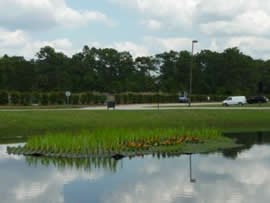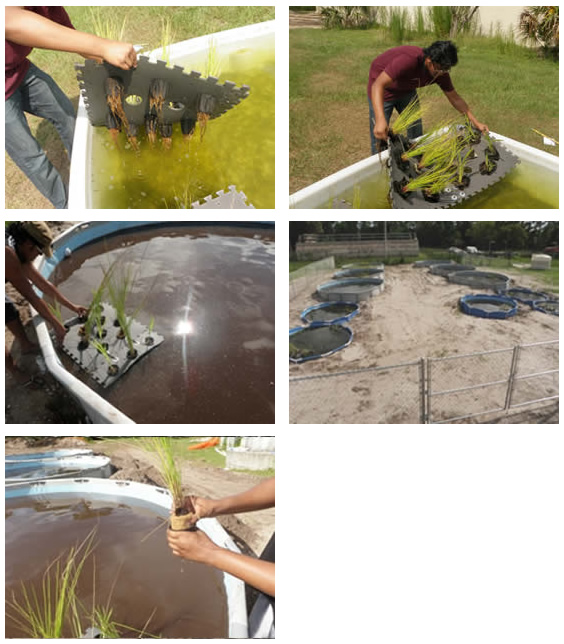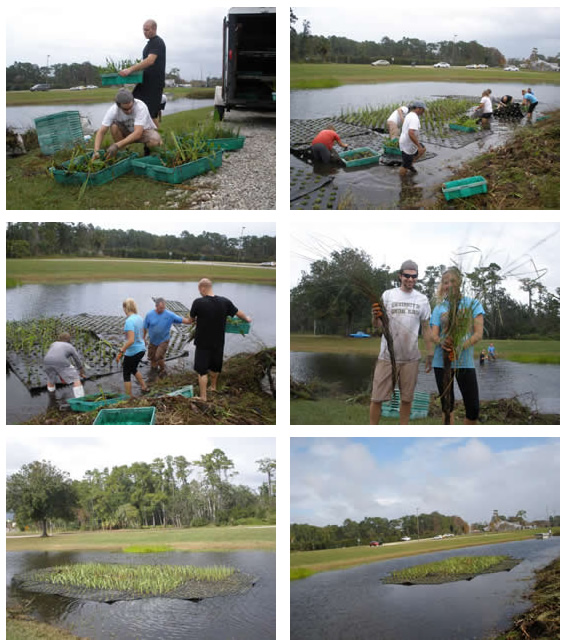The Stormwater Management Academy at the University of Central Florida (UCF) is working on a series of mesocosm and field experiments that intensively explore the possibility to using the floating wetland technologies in stormwater wet detention ponds and providing additional credits for nutrient removal in stormwater Best Management Practices (BMPs). The floating wetland technology is an emerging approach used for treating stormwater containing nutrients with various floating aquatic plants. Free-floating macrophytes provide shading of the water column, when uptaking nutrient fluxes as well as offering a habitat for fish and macro invertebrates. The hanging roots provide a large surface area for denitrifying bacteria creating an anaerobic environment, which can remove nitrate by a denitrification process, and these roots entrap fine suspended particulates that would otherwise remain in suspension in a conventional pond system.
1. Microcosm and Mesocosm Studies: Microcosm and mesocosm studies were carried out in late 2010 and early 2011 on campus:
To explore the ultimate removal efficiency of nitrogen and phosphorus, the floating treatment wetland project includes 11 mesocosms in water tanks with various sizes, floating mat sizes, and the use of sorption media, all of which replicate the field conditions of detention ponds. With 11 mesocosms available, 11 scenarios have been created varying percent area coverage, littoral zone and water depth. Case-1 and Case-2 are without any floating macrophytes performing as control cases. Sorption media has been used in all the cases except Case-7b which is control case in this regard. Considering feasibility of actual pond, percent area coverage has been limited to 10%. Two different water depths are 36 inches and 22 inches associated with bottom sediment thickness of 20 inches and 12 inches, respectively. A slope of 1:5 was maintained toward the center of the cylindrical water tanks for the bottom sediment layer.
One of the conclusions of the mesocosms is to use at most 5% pond area coverage for the floating wetlands. To verify the efficacy of floating wetland technology with 5% coverage,actual pond sampling is conducted at a wet detention pond on campus of UCF. The results of the pond sampling are used to show the removal efficiencies of the floating wetlands based on water quality sampling before and after the introduction of the floating wetlands.
2. Field Testing: Field deployment of the floating mats was carried out on April 8 2011.
Adjacent to the pilot study site of mesocosms (0.3 mile West), pond 4M with the area of 0.63 acres was selected as an actual pond for field study. A concrete structure was constructed at the outlet of the 4M pond. Its inner dimension is 54-inch long, 36-in wide and 86-in deep. Electronic equipments like flow rate meter (Georg Fischer Signet 2551 Magmeter Flow Sensor), water level sensor (Global Water WL400) along with common rain gage, evaporation pan were used to collect and monitor the hydrological data for the pond 4M. Data logger (Global Water GL500-2-1) was connected with the water level sensor and set to record the water level data at intervals of 15 minutes. The floating wetlands were deployed in Pond 4M on Apr 8th, 2011 with the coverage about 6.8 % to match the actual specification of the floating mats. Since Pond 4M is a kidney-shaped pond, algae species will probably aggregate at the two ends of the pond. Thus, two pieces of floating mats were deployed at both ends of the pond. And the third one was deployed close to the outlet to achieve a better outflow quality. Thousands of seedling including Canna and Juncus along with the flower and grass were planted on three integrated floating mats. The special sorption media designed for the enhancement of nutrient removal was added in each seedling container. The floating islands are expected to work as a kidney of nature for nutrient removal, providing a beautiful and peaceful habitat for birds and animals at the same time. The testing results confirm the promising performance of the floating wetland technologies in Dec. 2011 before replacement.
3. Field Maintenance: Invasive species could deteriorate the nutrient uptake. Maintenance is required after 7 months of deployment. Replacement of the plant species on the floating mats was carried out on Dec. 12 2011.




